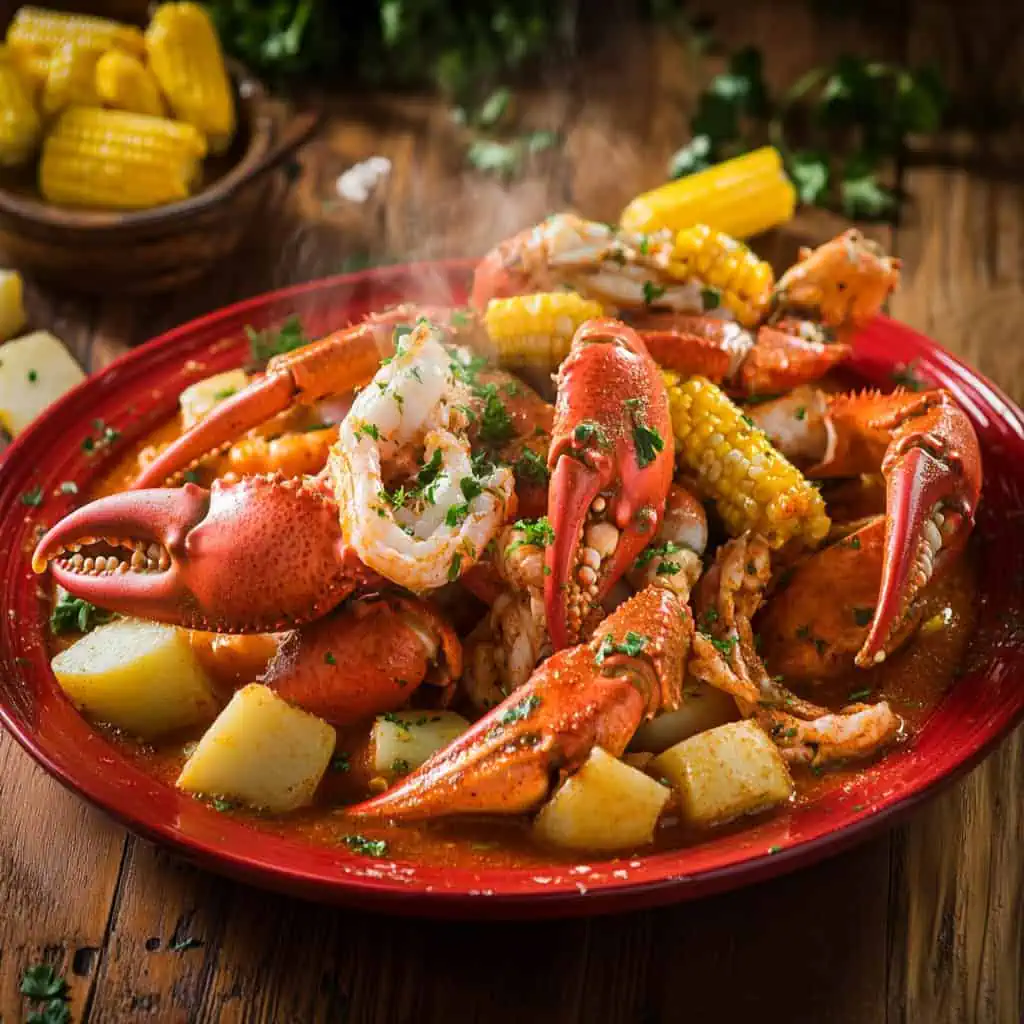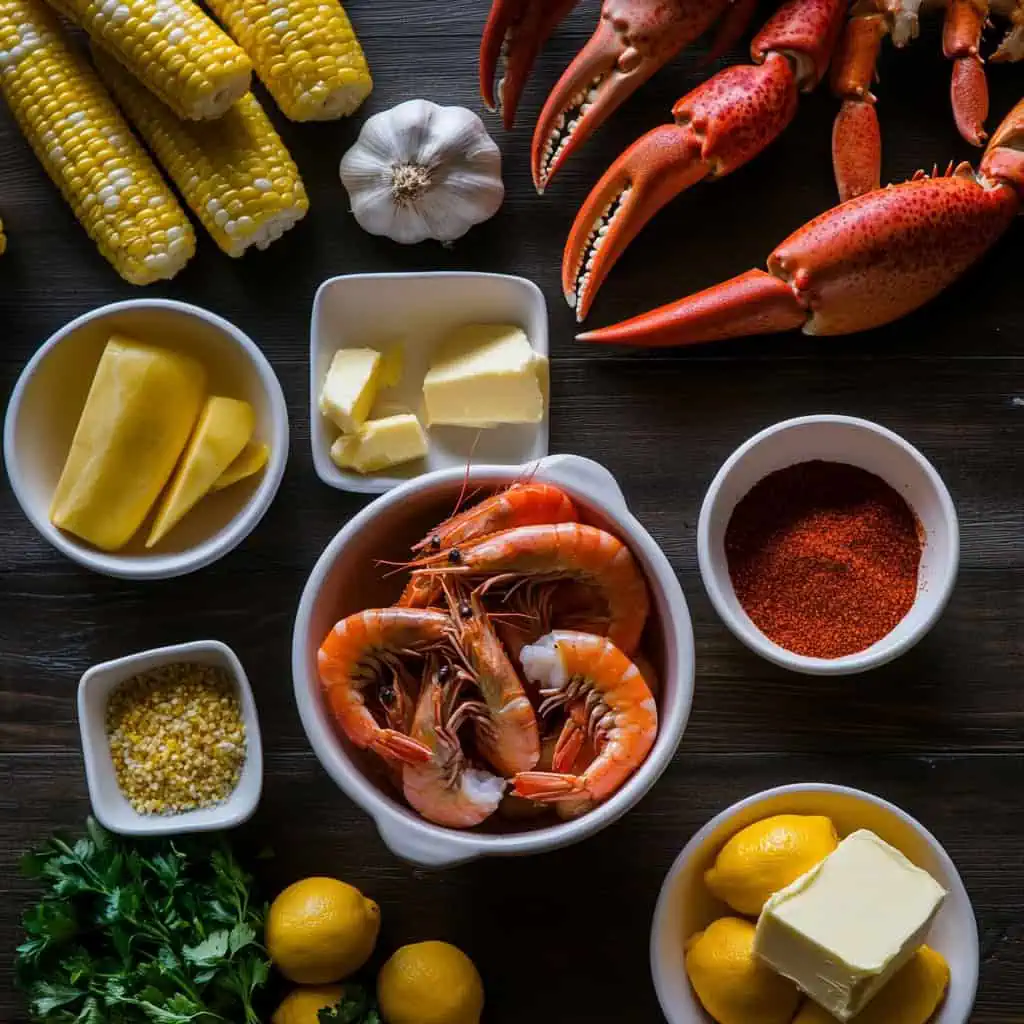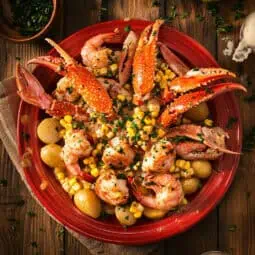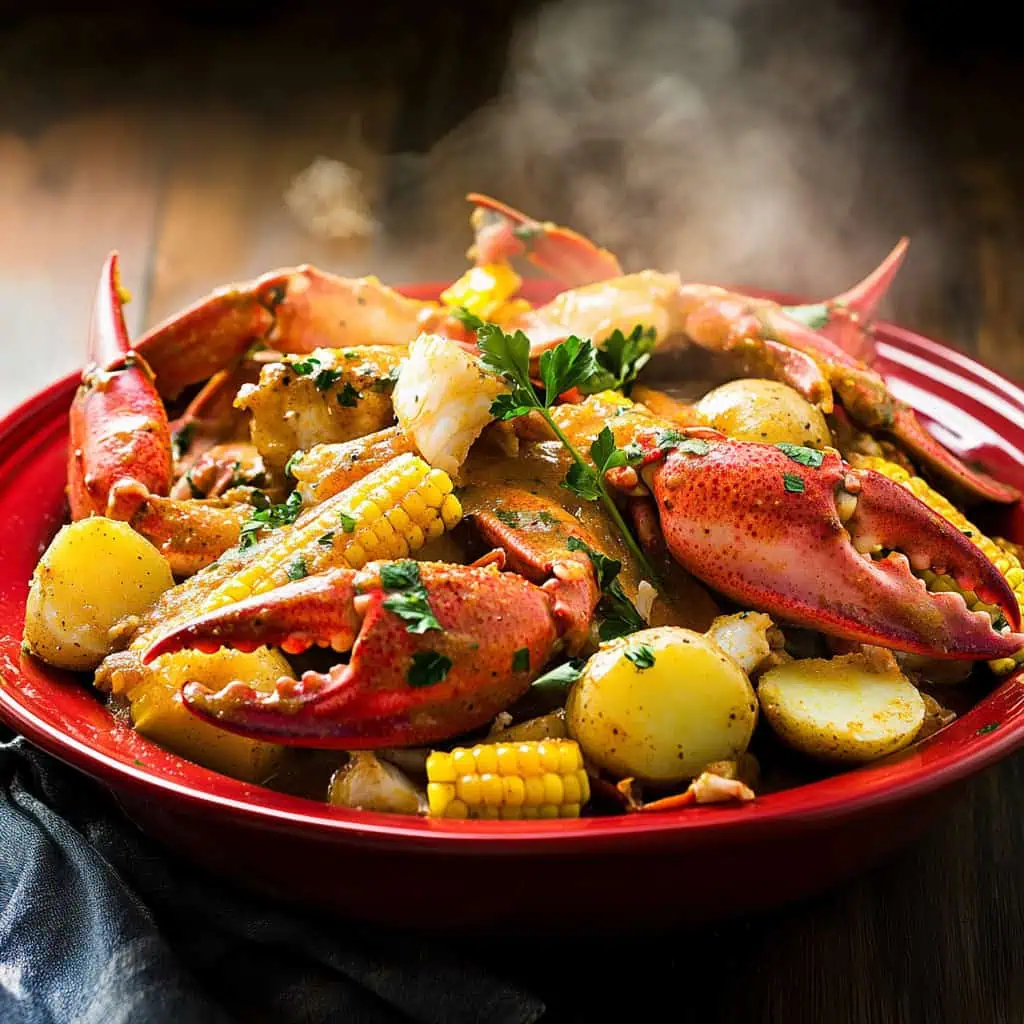I never thought I could make those fancy seafood trays at home until I tried this recipe. As someone who loves seafood but doesn't love the restaurant prices (those trendy seafood spots in Metro Manila can charge ₱2,000+ per tray!), this homemade version was a game-changer.
I get my seafood fresh from the market, mix it with simple spices, and create a butter sauce that makes everyone forget about expensive restaurant versions. My family now requests this for birthdays and gatherings. You should see how quickly everyone gathers around the table when I pour that golden butter sauce over the seafood!
You can make this at home for less than half the restaurant price, and you get to control everything - from how spicy you want it to which seafood you include. This recipe is super easy to follow. And here's a tip from my kitchen to yours: don't forget to prepare extra rice because that sauce is super sarap.
Jump to:

Why You'll Love This Recipe
- More affordable than restaurant versions (saves ₱2,000-3,000)
- Customizable with your favorite seafood
- Perfect for family gatherings or celebrations
- Creates an impressive presentation
- Can be prepared ahead of time
- Features both boiling and grilling options
Ingredients
Each component in this recipe serves a special purpose. The seafood (shrimp and crab) provides the star flavor while remaining tender and sweet. Smoked sausage adds a savory depth that balances the seafood's sweetness. Corn and potatoes absorb the flavorful broth and provide heartiness.
The aromatic blend of garlic, onion, and Old Bay creates a fragrant base, while the butter sauce delivers a rich, spicy finish that ties everything together, creating a perfect balance of flavors and textures in every bite.

For the Seafood Boil:
- 1 kilogram shrimp (hipon), heads on, cleaned and trimmed
- ½ kilogram crab legs/claws (alimango or mud crabs)
- 1 pound smoked sausage or longganisa, cut into 1-inch pieces
- ½ pound baby potatoes, halved
- 2 corn on the cob, cut into 4" pieces
- 3 fresh lemons
- ½ cup Old Bay seasoning
- 5 cloves garlic, smashed
- 1 onion, peeled and cut into 6 pieces
- 2 tablespoons chopped parsley
For the Cajun Sauce:
- 1 cup unsalted butter
- 4 cloves garlic, minced
- 2 tablespoons hot sauce
- 2 tablespoons Cajun seasoning
- 2 tablespoons paprika
- 2 tablespoons cayenne pepper
- ½!-- /wp:list-item -->
Equipment
- Large stockpot (kaldero): For boiling the seafood and vegetables; choose one that can hold at least 5 liters
- Colander (salaan): To drain the seafood after boiling
- Measuring cups and spoons (panukat): For precise seasoning measurements
- Sharp knife (kutsilyo): For preparing ingredients
- Cutting board (sangkalan): For safe food preparation
- Small skillet (kawali): For preparing the Cajun butter sauce
- Mixing bowls (mangkok): For combining seasonings
- Tongs (sipit): For handling hot seafood safely
- Heavy-duty aluminum foil: If using the grilling method
- Large serving tray: For the final presentation

How To Make
- Prep all ingredients: Gather everything you'll need. Quarter two lemons (save the third for garnish). Slice the sausage into 1-inch pieces, halve the potatoes, cut the corn into 4-inch pieces, and ensure all seafood is properly cleaned.
- Prepare the boiling liquid: Fill your large pot with 2-3 liters of water (enough to cover all ingredients). Add the quartered lemons, Old Bay seasoning, smashed garlic cloves, and onion pieces. Bring to a full boil over high heat.
- Cook in stages: Once boiling, add potatoes and crab legs first. Cook for 8 minutes. Then add corn pieces and continue cooking for 5 more minutes.
- Add quick-cooking seafood: Add the shrimp and sausage to the pot. Cook for just 2-3 minutes until shrimp turn pink and curl slightly. Avoid overcooking or your shrimp will become tough and rubbery.
- Prepare the Cajun sauce: While the seafood finishes cooking, prepare your sauce. In a bowl, combine Cajun seasoning, paprika, cayenne, and hot sauce. In a skillet, melt the butter over medium heat, add minced garlic, then stir in your seasoning mixture.
- Reserve broth and drain: Save 1 cup of the cooking broth, then drain everything in a colander. Transfer all seafood, sausage, corn, and potatoes to a large serving tray.
- Assemble the feast: Drizzle some reserved broth over everything, then pour your warm Cajun butter sauce on top. Sprinkle with fresh chopped parsley and arrange lemon wedges around the tray.
- Alternative grilling method: If preferred, lay out four large pieces of foil and divide ingredients equally between them. Pour sauce over each portion and seal packets tightly. Cook on a hot grill for 12-15 minutes, or in a 425°F oven for 15-17 minutes until everything is cooked through.
- Serve immediately: Provide plenty of napkins, a bowl for shells, and some warm water with lemon for cleaning hands. Serve with rice if desired, and encourage everyone to dig in with their hands for the authentic seafood boil experience.

Tips from Lola's Kitchen
- Choose seafood carefully: Look for bright eyes and a fresh ocean smell when buying seafood. The fresher your ingredients, the better your final dish.
- Timing is everything: Different seafood requires different cooking times. Follow the layered cooking technique to ensure nothing gets overcooked or undercooked.
- Watch your shrimp: They cook in just 2-3 minutes! Remove them as soon as they turn pink and opaque to prevent rubbery texture.
- Make the broth flavorful: Don't skimp on the Old Bay seasoning in your boiling liquid – it infuses everything with flavor.
- Layered heat: Add spices in stages for more complex flavor. Some in the boil, some in the sauce.
- Presentation matters: Serve on banana leaves or clean newspaper for an authentic experience that also makes cleanup easier.
- Don't waste the broth: Save leftover seafood broth for future soups or sauces – it's liquid gold!
- Butter temperature: Melt butter slowly to prevent separation in your sauce.
- Taste as you go: Always taste and adjust seasonings, especially when working with spicy ingredients.
- Serve immediately: This dish is best enjoyed right away while everything is hot and the aromas are at their peak.
Substitutions
- Seafood options: Can't find crab legs? Use whole crabs, lobster tails, mussels (tahong), clams (halaan), or squid (pusit) instead.
- Sausage alternatives: Regular longganisa works well, or try chorizo, kielbasa, or even hot dogs for a budget option.
- Old Bay seasoning: Make your own by combining paprika, celery salt, black pepper, cayenne pepper, dry mustard, and ground bay leaves.
- Cajun seasoning: Create a homemade version with paprika, garlic powder, onion powder, thyme, oregano, black pepper, and cayenne.
- Butter options: While real butter gives the best flavor, margarine can work in a pinch. For a richer sauce, try adding a splash of heavy cream.
- Corn substitutes: When corn is expensive, try using corn cuts or even kamote (sweet potatoes) as an alternative starchy vegetable.
- Heat adjustments: Reduce cayenne and hot sauce for a milder version, or add sili labuyo (bird's eye chilies) for extra heat.
Troubleshooting
- Rubbery shrimp: You've overcooked them. Next time, remove shrimp as soon as they turn pink (2-3 minutes maximum).
- Sauce too spicy: Add more butter or a splash of cream to dilute the heat. A little sugar can also help balance extreme spiciness.
- Bland seafood: Increase Old Bay seasoning in your boil and make sure to let ingredients sit in the hot broth for a few minutes before draining.
- Sauce separation: Your butter broke. Reheat very slowly while continuously whisking, or add a small splash of cold water to help it re-emulsify.
- Undercooked potatoes: They take longest to cook. Either cut them smaller next time or give them a head start by parboiling for 5 minutes before adding to the seafood boil.
- Seafood sticking to shells: This means they're overcooked. Try reducing cooking time or using the foil packet method which retains more moisture.
- Too salty: Balance with a squeeze of fresh lemon juice or add more butter to dilute.
Storage & Reheating
- Refrigeration: Store leftovers in an airtight container in the refrigerator for up to 2-3 days.
- Separate storage: For best results, store seafood separate from potatoes and corn.
- Sauce storage: Refrigerate leftover sauce in a separate container – it will solidify but can be gently reheated.
- Not freezer-friendly: Freezing is not recommended for cooked seafood as it significantly changes the texture.
- Best reheating method: Gently steam leftovers for 2-3 minutes until just heated through.
- Microwave caution: If using a microwave, use 50% power and cover with a damp paper towel to prevent drying out.
- Sauce revival: If sauce has separated after storage, slowly reheat while whisking constantly.
- Fresh finish: After reheating, add a small pat of fresh butter and a squeeze of lemon to bring flavors back to life.

FAQ
How do I know when each type of seafood is perfectly cooked?
Shrimp turn pink and form a C-shape when done (2-3 minutes). Crab meat becomes opaque and easily pulls from the shell (8-10 minutes). Fish is done when it flakes easily with a fork.
Can I prepare this dish in advance for a party?
You can prep all ingredients and make the sauce ahead of time, but cook the seafood right before serving for best results. If needed, you can cook everything 30 minutes ahead and keep warm in a low oven (170°F/75°C).
Where can I find Old Bay seasoning in the Philippines?
Look in the international section of major supermarkets like SM, Robinsons, or Rustan's. It's also available on Lazada and Shopee. If you can't find it, make your own with the substitution recipe provided above.
Is this recipe child-friendly?
The base recipe has medium heat. For kids, set aside a portion before adding cayenne and hot sauce, or create a separate mild butter sauce with just garlic and a touch of paprika.
How can I make this more affordable?
Focus on locally abundant seafood like tahong (mussels) and halaan (clams) which are often less expensive than crab and shrimp. Increase the corn and potatoes portion, which are filling but inexpensive.
What's the best way to eat this dish?
The traditional way is with your hands! Provide finger bowls with warm lemon water for cleaning hands between bites. Have plenty of napkins ready and a separate bowl for shells.
Can I use frozen seafood?
Yes, but thaw completely in the refrigerator overnight, pat dry before cooking, and reduce cooking time slightly as frozen seafood sometimes cooks faster once thawed.
What sides pair well with this seafood boil?
Steamed white rice is the Filipino favorite. Other good options include garlic bread, ensaladang mangga (green mango salad), or a simple cucumber-tomato side salad to balance the richness.
Related
Looking for other recipes like this? Try these:

Ultimate Filipino-Style Seafood Boil (with Cajun Sauce)
Equipment
- Large stockpot (kaldero) for boiling seafood and vegetables
- Colander (salaan) for draining the seafood
- Measuring cups and spoons (Panukat) for precise seasoning
- Sharp knife (kutsilyo) for preparing ingredients
- Cutting board (Sangkalan) for ingredient preparation
- Small skillet (kawali) for preparing the sauce
- Mixing bowls (mangkok) for combining seasonings
- Tongs [Sipit] for handling seafood
- Heavy-duty aluminum foil for grilling method
Ingredients
For the Seafood Boil:
- 1 kilogram shrimp hipon, heads on, cleaned and trimmed
- ½ kilogram crab legs/claw alimango or mud crabs
- 1 pound smoked sausage longganisa, cut into 1-inch pieces
- ½ pound baby potatoes maliliit na patatas, halved
- 2 corn on the cob mais, cut into 4" pieces
- 3 fresh lemons
- ½ cup Old Bay seasoning
- 5 cloves garlic bawang, smashed
- 1 onion sibuyas, peeled and cut into 6 pieces
- 2 tablespoons chopped parsley kintsay
For the Cajun Sauce:
- 1 cup unsalted butter mantikilya
- 4 cloves garlic bawang, minced
- 2 tablespoons hot sauce
- 2 tablespoons Cajun seasoning
- 2 tablespoons Paprika
- 2 tablespoons Cayenne
- ½ cup reserved broth
Instructions
- Start by gathering all your ingredients and equipment. You'll need a large pot for boiling and a skillet for the sauce. Cut two of your lemons into quarters and save the third lemon for garnish. Slice the sausage into 1-inch pieces, halve the potatoes, cut the corn into 4-inch pieces, and make sure your seafood is clean.
- Fill your large pot with enough water to cover all ingredients, about 2-3 liters. Add the quartered lemons, Old Bay seasoning, smashed garlic cloves, and onion pieces to the water. Turn the heat to high and bring everything to a boil.
- Once the water is boiling, add your potatoes and crab legs first. Let these cook for 8 minutes since they take the longest. After 8 minutes, add the corn pieces and cook for another 5 minutes.
- Now add the shrimp and sausage pieces to the pot. These only need 2-3 minutes to cook. You'll know the shrimp is done when it turns pink and curls slightly. Don't overcook or the shrimp will become tough.
- While everything is finishing in the pot, make your sauce. In a small bowl, mix together the Cajun seasoning, paprika, cayenne, and Louisiana hot sauce. In a skillet, melt the butter over medium heat, add the minced garlic, then stir in your seasoning mixture.
- Save 1 cup of the cooking broth from the pot, then drain everything else. Place all your seafood, sausage, corn, and potatoes in a large serving dish or tray. Drizzle some of the reserved broth over everything, then pour your warm Cajun butter sauce on top.
- Finish by sprinkling fresh chopped parsley over everything and arrange lemon wedges around the tray. Serve right away while hot, with extra sauce on the side for dipping.
- If you're using a grill or oven instead, lay out four large pieces of foil and divide all ingredients equally between them. Pour the sauce over each portion and seal the foil packets tightly. Cook on a hot grill for 12-15 minutes, or in a 425°F oven for 15-17 minutes until everything is cooked through.
- Remember to provide plenty of napkins, a bowl for shells, and some warm water with lemon for cleaning hands. Serve with rice if desired, and encourage everyone to dig in with their hands for the true seafood boil experience.
Tips from Lola's Kitchen
- Use fresh seafood whenever possible (mas masarap ang sariwang seafood)
- Don't overcook the shrimp to prevent rubbery texture
- Save the seafood broth for future recipes
- Adjust spiciness according to your preference
- Add butter gradually to prevent sauce separation
- Use newspaper or banana leaves for authentic presentation
Nutrition
The Story Behind our Filipino Seafood Boil
The seafood boil, though not originally Filipino, has found a special place in our local food scene, especially during the height of the food delivery trend in 2020-2021. What started in the American South, particularly in Louisiana's Cajun country, has been lovingly adapted to Filipino tastes and transformed into an affordable luxury we can create at home.
Traditional seafood boils, or low country boils as they're known in the Louisiana area, were community events where fresh seafood, corn, and potatoes were boiled together with spices and served on newspaper-covered tables. Here in the Philippines, we've embraced this concept wholeheartedly - after all, we're a nation of seafood lovers with access to some of the freshest seafood in the world. From the bountiful waters of Roxas City to the bustling markets of Navotos, our local ingredients make this dish truly special.
The Filipino twist on the seafood boil reflects our love for both flavor and value. While trendy restaurants in BGC, Makati, and other urban areas charge premium prices for seafood trays (often ₱1,500-3,000 per serving), home cooks have discovered they can recreate these luxurious spreads for a fraction of the cost. We've adapted the recipe to include local favorites like tahong (mussels) and halaan (clams), while keeping the signature Cajun butter sauce that makes this dish irresistible.
What makes our version unique is how it bridges cultures - combining American Cajun seasonings with Filipino seafood traditions. The spicy, buttery sauce reminds many of their favorite Filipino seafood dishes like halabos na hipon or ginataang alimango, but with an international twist. It's become a popular choice for family celebrations, replacing or accompanying traditional Filipino seafood dishes at special occasions.
The rise of seafood boils in Filipino homes also speaks to our love of shared meals or "budol fights" - there's something genuinely Filipino about gathering around a table, eating with our hands, and sharing a bountiful spread of seafood with loved ones. The dish has become so popular that even local palengkes and supermarkets have started stocking ingredients like Old Bay seasoning and Cajun spice blends, making it easier for home cooks to recreate this feast.
Today, this dish represents the best of modern Filipino cooking - taking international flavors, adapting them to local tastes and ingredients, and making them accessible to every home cook. Whether you're preparing it for a special occasion or just wanting to treat your family to something special, this seafood boil brings restaurant-quality dining to your own kitchen, proving that the best meals are indeed the ones made at home.










Comments
No Comments